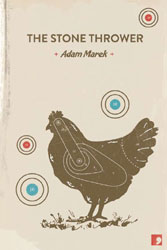‘Medical section’s upstairs,’ she told me.
‘I think it should be in fiction.’
‘Then we don’t got it.’
Instruction Manual for Swallowing was Adam Marek’s first collection for Comma Press, a publisher remarkable for its consistent brilliance and commitment to the short story. Having spent some time promising to follow it up with a novel, this year Marek has instead published a second collection, The Stone Thrower.
Instruction Manual was going to be hard to follow for two reasons. In the first place it is an excellent collection, well structured and full of imaginative, perfectly paced stories. But in the second, the surprise of Marek’s style would now be expected. But neither of these are a problem.
I’ll admit early that I’m a fan. I think Marek’s Instruction Manual was the best short story debut I’ve read since Carver’s will you please be quiet, please? And like Carver – as with many writers on Comma’s list – the story ends just before you feel it ought to. In ‘Remember the Bride who got Stung’, for example, we trust and follow the conventional narrative over the fields and into the woods, antagonistic parents and child together, with Marek employing distractingly good observation. It’s a mundane storyline, but it becomes infused with horror and tension, and two steps before the tension is to peak… the story ends. Reading Marek’s work can remind you of prodding a favourite bruise.
But in spite of being black and blue I trust Marek’s abuse is for the best. The story not having a ‘conventional’ ending means that you are pulled back into it again to consider it better. You wonder what he’s up to, why he’s hurting you like this. Perhaps it’s an existential illusion he is breaking, of being led by the hand through the world. Marek takes your hand, leads you into the woods then abandons you like the boy in Blake’s ‘The Little Boy Lost’ who follows a corpse candle onto the mire thinking it’s his father. (I hope my analyst doesn’t read this. (I hope Adam Marek doesn’t read this either – I’m being creepy. (But how many readers is it safe to exclude? I’ll never be famous this way.))) Or perhaps Marek is drawing attention to the idea that the real story is not in the narrative. (Does this sound creepy too? (Again. (Again. (Now I sound like the Teletubbies.)))) It’s as though the narrative is a tool which the writer feels happy to put down and forget about, job done.
Whatever the reason, it is testament to the quality of the writing and the reader’s confidence in the writer that even though no ‘ending’ is given you do not feel that the ending is ambiguous. You do not feel that it could go either way – that the ending is open – it is just that you don’t know which way it has gone. Put another way, you do not feel that the narrative stops, even though the story has stopped.
Abused and abandoned by Marek I still look forward to the novel. His fablish sort of magical realism and instinct for horror would no doubt translate as intriguingly for Marek as it did for the Argentine, Julio Cortazar.
It may be unfair to compare Marek to writers like Cortazar, but I’m doing it partly because on the front of The Stone Thrower there is an annoying cover quote taken from The Independent describing the book (or Marek) as ‘Early McEwan meets David Cronenburg’. I can’t help feeling that this is unhelpful, and probably a marketing error. The people reading Marek will be people interested in great new experimental short stories, and to these people Ian McEwan lost his cool long ago. More than that, I think Marek’s writing is better, his imagination more exciting, and he more relevant.
So The Stone Thrower is no less exciting than Instruction Manual, but it is better structured. There are recurring themes which haunt the stories and make it a better sequence than the earlier collection. You will be hard pushed to find a better short story publisher than Comma Press, hard pushed to find a better constructed collection of stories than this, and hard pushed indeed to find a single tale so skilfully wrought as ‘Tamagotchi’.
(For reference, I did find Instruction Manual for Swallowing in the ‘Medical’ section of that Cardiff bookshop, with The Stone Thrower under ‘Occupational’.)
The Stone Thrower is published by Comma Press (2013). Buy your copy here.
Luke Thompson is studying for a PhD on the poet Jack Clemo at Exeter University. He has published stories, reviews and prose poems in many magazines, including Flash, Spilling Ink Review, Cinnamon Press’s Exposure anthology, and East of the Web. Luke is also a fishmonger.

